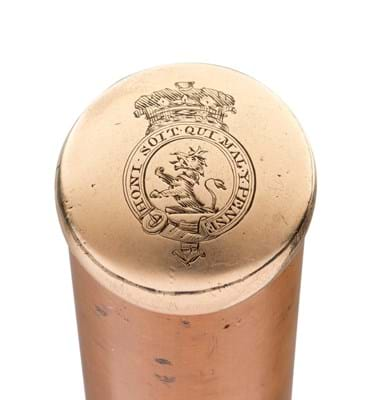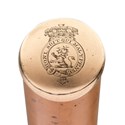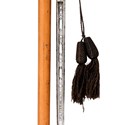It was a sword cane belonging to Field Marshal the Rt Hon Sir Henry Paget, 1st Marquess of Anglesey (1768-1854), who was commander of the allied cavalry at the Battle of Waterloo.
As the friendly, stiff-upper-lip, mid-battle chat above probably indicates, he was in need of help in walking afterwards – grapeshot severely wounded him in the right knee towards the end of the titanic encounter in 1815 and that leg was subsequently amputated above the knee.
Anglesey displayed the same sense of calm during the impromptu operation. John Robert Hume, the Deputy Inspector of Medical Staff, wrote: “His lordship was perfectly cool, his pulse was calm and regular, as if he had just risen from his bed in the morning, and he displayed no expression of uneasiness though his suffering must have been extreme.”
He used a series of bespoke, articulated, prosthetic right legs for the rest of his life. After convalescence, as contemporary illustrations record, Anglesey generally walked with the aid of two sticks.
This sword cane, c.1818-28, consigned from a private collection, featured a 17th century tapering slender 2ft 5in long blade stamped Johannis and Meigen on the respective faces. The gold grip has a finial engraved with the crest of the 1st Marquess of Anglesey surrounded by The Garter and surmounted by a marquess’ coronet.
On sale day, four phone bidders competed with room and online interest. A UK private collector bidding on the phone secured the cane for £6500 (estimate £3000-5000).
Personal protection
Sir Henry Paget was a daring cavalry commander. Initially the Earl of Uxbridge, after Waterloo in recognition of his services he was created Marquess of Anglesey.
Late in 1827 he was appointed lord lieutenant of Ireland for just a year, but served in that role again from 1830-33.
Despite the obvious need for walking support, this cane was probably more about personal protection. The saleroom said: “While he was a comparatively popular lord lieutenant because of his evident sympathy for the cause of Catholic emancipation, his role remained one on which he would have been in constant personal danger of attack.
“It is possible that this cane purchased by Anglesey prior to his passage to Ireland in 1827, although it is equally possible he bought it a decade earlier – late Regency and Georgian Britain being a place in which gentlemen habitually went armed against the possibility of being attacked and robbed in the streets.
“While Paget was created a marquess in 1815, the presence of The Garter around the crest engraved into the cap indicates that the cane must post-date 1818 – Anglesey being appointed a Knight Companion of the Order of the Garter in that year.”









